Costas loop
A Costas loop is a phase-locked loop based circuit which is used for carrier phase recovery from suppressed-carrier modulation signals, such as from double-sideband suppressed carrier signals. It was invented by John P. Costas at General Electric in the 1950s. Its invention was described as having had "a profound effect on modern digital communications". The primary application of Costas loops is in wireless receivers. Its advantage over the PLL-based detectors is that at small deviations the Costas loop error voltage is sin(2(θi−θf)) vs sin(θi−θf). This translates to double the sensitivity and also makes the Costas loop uniquely suited for tracking doppler-shifted carriers esp. in OFDM and GPS receivers [1]
Classical implementation
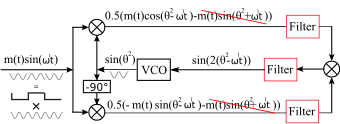 Costas loop, before synchronization |
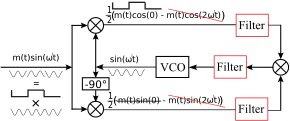 Costas Loop after synchronization |
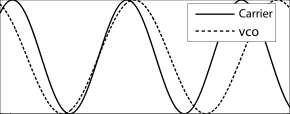 Carrier and VCO signals before synchronization |
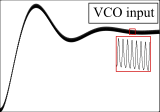 VCO input during synchronization |
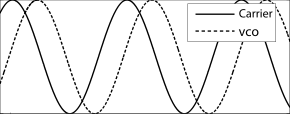 Carrier and VCO signals after synchronization |
In the classical implementation of a Costas loop,[2] a local voltage-controlled oscillator (VCO) provides quadrature outputs, one to each of two phase detectors, e.g., product detectors. The same phase of the input signal is also applied to both phase detectors and the output of each phase detector is passed through a low-pass filter. The outputs of these low-pass filters are inputs to another phase detector, the output of which passes through noise-reduction filter before being used to control the voltage-controlled oscillator. The overall loop response is controlled by the two individual low-pass filters that precede the third phase detector while the third low-pass filter serves a trivial role in terms of gain and phase margin.
Mathematical models of Costas loop
Model of Costas loop in the time domain

In the simplest case  . Therefore,
. Therefore,  does not affect the input of noise-reduction filter.
Carrier and VCO signals are periodic oscillations
does not affect the input of noise-reduction filter.
Carrier and VCO signals are periodic oscillations  with high-frequencies
with high-frequencies  .
Block
.
Block  shifts phase of VCO signal by
shifts phase of VCO signal by  .
Block
.
Block  is an Analog multiplier.
is an Analog multiplier.
From the mathematical point of view, a linear filter can be described by a system of linear differential equations
Here,  is a constant matrix,
is a constant matrix,  is a state vector of filter,
is a state vector of filter,  and
and  are constant vectors.
are constant vectors.
The model of voltage-controlled oscillator is usually assumed to be linear
where  is a free-running frequency of voltage-controlled oscillator and
is a free-running frequency of voltage-controlled oscillator and  is an oscillator gain. Similar it is possible to consider various nonlinear models of VCO.
is an oscillator gain. Similar it is possible to consider various nonlinear models of VCO.
Suppose that the frequency of master generator is constant
 Equation of VCO and equation of filter yield
Equation of VCO and equation of filter yield
The system is nonautonomous and rather difficult for investigation.
Model of Costas loop in phase-frequency domain

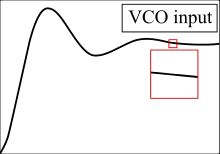
In the simplest case, when
standard engineering assumption is that the filter removes the upper sideband
with frequency from the input but leaves the lower sideband without change.
Thus it is assumed that VCO input is  .
This makes Costas loop equivalent to Phase-Locked Loop with phase detector characteristic
.
This makes Costas loop equivalent to Phase-Locked Loop with phase detector characteristic  corresponding to the particular waveforms
corresponding to the particular waveforms  and
and  of input and VCO signals. It can be proved, that inputs
of input and VCO signals. It can be proved, that inputs  and
and  of VCO for phase-frequency domain and time domain models are almost equal.
[3]
[4]
[5]
of VCO for phase-frequency domain and time domain models are almost equal.
[3]
[4]
[5]
Thus it is possible [6] to study more simple autonomous system of differential equations
Well-known Krylov–Bogoliubov averaging method allows one to prove that solutions of nonautonomous and autonomous equations are close under some assumptions. Thus the block-scheme of Costas Loop in the time space can be asymptotically changed to the block-scheme on the level of phase-frequency relations.
The passage to analysis of autonomous dynamical model of Costas loop (in place of the nonautonomous one) allows one to overcome the difficulties, related with modeling Costas loop in time domain where one has to simultaneously observe very fast time scale of the input signals and slow time scale of signal's phase.
References
- ↑ D. Taylor (August 2002). "Introduction to `Synchronous Communications', A Classic Paper by John P. Costas" (PDF). Proceedings of the IEEE 90 (8): pp. 1459–1460. doi:10.1109/jproc.2002.800719.
- ↑ Jeff Feigin (January 1, 2002). "Practical Costas loop design" (PDF). RF Design: pp. 20–36.
- ↑ G.A. Leonov, N.V. Kuznetsov, M.V. Yuldashev, R.V. Yuldashev (August 2012). "Differential equations of Costas loop" (PDF). Doklady Mathematics 86 (2): pp. 723–728. doi:10.1134/s1064562412050080.
- ↑ Leonov G.A., Kuznetsov N.V., Yuldashev M.V., Yuldashev R.V. (2012). "Analytical method for computation of phase-detector characteristic" (PDF). IEEE Transactions on Circuits and Systems Part II 59 (10): pp. 633–637. doi:10.1109/tcsii.2012.2213362.
- ↑ Leonov G.A., Kuznetsov N.V., Yuldashev M.V., Yuldashev R.V. (2015). "Nonlinear dynamical model of Costas loop and an approach to the analysis of its stability in the large". Signal processing (Elsevier) 108: pp. 124–135. doi:10.1016/j.sigpro.2014.08.033.
- ↑ Kuznetsov N.V., Leonov G.A., Neittaanmaki P., Seledzhi S.M., Yuldashev M.V., Yuldashev R.V. (2012). "Nonlinear mathematical models of Costas Loop for general waveform of input signal". IEEE 4th International Conference on Nonlinear Science and Complexity, NSC 2012 - Proceedings (IEEE Press) (6304729): pp. 75–80. doi:10.1109/NSC.2012.6304729.
 This article incorporates public domain material from the General Services Administration document "Federal Standard 1037C".
This article incorporates public domain material from the General Services Administration document "Federal Standard 1037C".

![\begin{array}{ll}
\dot\theta^2(t) = \omega^2_{free} + LG(t),& t \in [0,T],
\end{array}](../I/m/bd00cea2e4e75a70d13e48bba42fca66.png)


